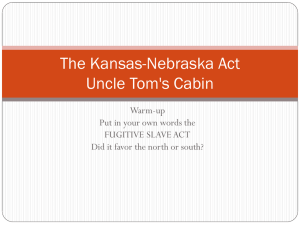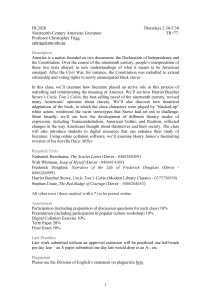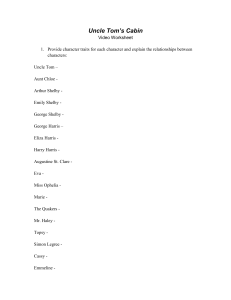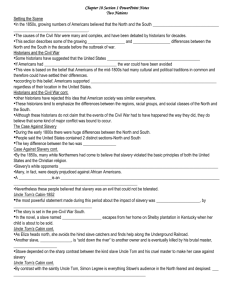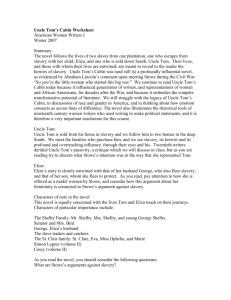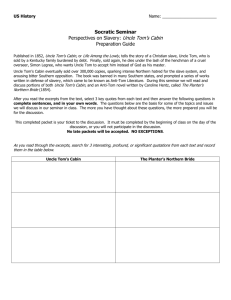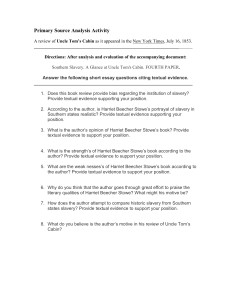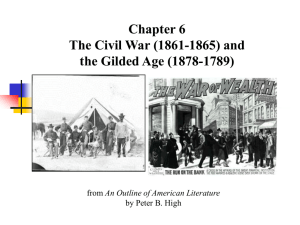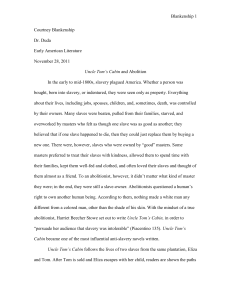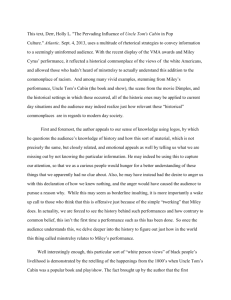Students will know…
advertisement
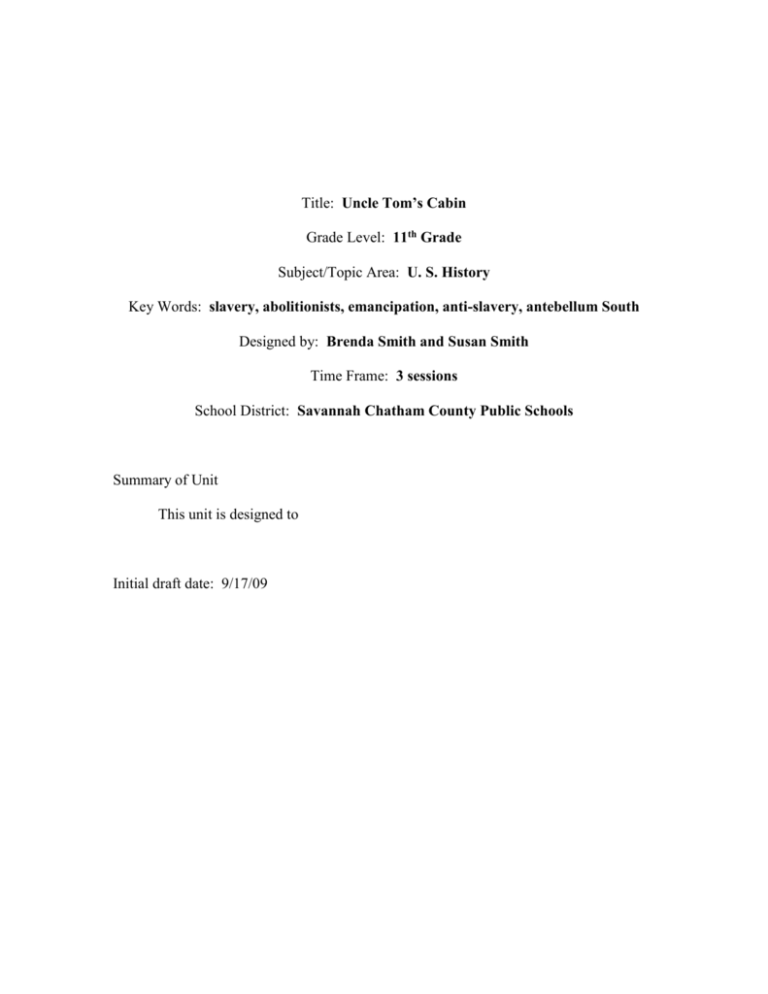
Title: Uncle Tom’s Cabin Grade Level: 11th Grade Subject/Topic Area: U. S. History Key Words: slavery, abolitionists, emancipation, anti-slavery, antebellum South Designed by: Brenda Smith and Susan Smith Time Frame: 3 sessions School District: Savannah Chatham County Public Schools Summary of Unit This unit is designed to Initial draft date: 9/17/09 Stage 1—Identify Desired Results Learner Analysis The students were administered a pre-assessment to determine their current standing in regards to literacy skills. The instrument used was the online TRAILS Tool for Realtime Assessment of Information Literacy Skills. The pdf file of the results is attached to this lesson plan. One of the areas of concern is the ability to recognize how to use information responsibly, ethically, and legally. The overall correct responses in this area were just 55%. Therefore, this is the area that is addressed most directly by this lesson plan. Established Goals: SSUSH6 The student will analyze the nature of territorial and population growth and the impact of this growth in the early decades of the new nation. SSUSH7 Students will explain the process of economic growth, its regional and national impact in the first half of the 19th century, and the different responses to it. SUSH8 The student will explain the relationship between growing north-south divisions and westward expansion. 21st Century Learner Standard 1.3.1. Respect copyright/intellectual property rights of creators and producers. 1.3.5. Use Information technology responsibly. 2.1.2. Organize knowledge so that it is useful. 2.1.4. Use technology and other information tools to analyze and organize information. 2.1.6. Use the writing process, media and visual literacy, and technology skills to create products that express new understandings. 2.2.4. Demonstrate personal productivity by completing products to express learning. 3.1.3. Use writing and speaking skills to communicate new understandings effectively. 3.1.4. Use technology and other information tools to organize and display knowledge and understanding in ways that others can view, use, and assess. 3.4.2. Assess the quality and effectiveness of the learning product. 4.1.3. Respond to literature and creative expressions of ideas in various formats and genres. 4.1.8. Use creative and artistic formats to express personal learning. What essential questions will be considered? How did the perception of slavery differ between socio-economic groups and geographical groups? What role did religion play in Uncle Tom’s Cabin? Why? How did the indignation over slavery lead to the writing of Uncle Tom’s Cabin and how did the writing of Uncle Tom’s Cabin lead to the indignation over slavery? What understandings are desired? Powerful literary works can impact ideas, which in turn, can impact history. The struggle to abolish slavery in America forever changed the character of the young country. What key knowledge and skills will students acquire as a result of this unit? Students will know… The impact of slavery on the economy of the southern states. The events following the publication of “Uncle Tom’s Cabin”. The impact of the novel on the impending conflict of the Civil War. The impact of the novel on European support for the north and the south as the Civil War begins to tear apart the nation. Students will be able to… Read a literary work and research the cultural environment in which it was written and published. Compare and contrast northern and southern attitudes regarding slavery in the early 1800s. Analyze the literary elements of a fictional work. Plan and design a multi-media presentation to convey meaning and ideas. Research and gather data and resources to support writing and production. Stage 2—Determine Acceptable Evidence Performance Tasks: Students will read “Uncle Tom’s Cabin” by Harriett Beecher Stowe. Students will prepare a report on the literary elements of the novel as well as its effect on the rising tensions between the northern and southern states. Students will include information on the book’s effect on European perception of the conflict between the regions. Students will research the book and it’s influence on events through research of primary and secondary resources. A multi-media presentation will be prepared by the students to communicate the novel and it’s significance on the rising conflict. Other Evidence: Students will be able to discuss and debate the importance of “Uncle Tom’s Cabin” as a catalyst for the Civil War. Student Self-Assessment and Reflection: Participants will complete a self-evaluation Stage 3—Plan Learning Experiences W. H. E. R. E. T. O. 1. Begin the session with the animoto short “Day of Tears” to demonstrate how a sequential still presentation is used to present a synapses of a book. http://animoto.com/play/OxkJtA5TuH37xKRSeYuNnA#embed. H 2. Demonstrate the steps involved in creating a short book video using animoto. W 3. Distribute handouts of copyright guidelines as well as bookmarks with list of online resources for royalty-free music, public domain and creative common photos, image files, and online citation tools. W 4. Distribute copies of the book, “Uncle Tom’s Cabin” and guiding questions to be used by the students as they read. W 5. Allow students time to discuss the book in small reading circles. E 6. Have the students read the chapter on rising tensions prior to the Civil War for key events. E 7. Handout the timeline organizer showing the major events including the publication of “Uncle Tom’s Cabin”.E 8. Distribute rubric for the book reports and the rubrics for the presentations. W 9. Watch the movie, “Uncle Tom’s Cabin” and discuss differences between the film and the book. R 10. Have students present their multi-media book reports and allow other students to ask questions and give feedback. R 11. Distribute self-evaluation to students to encourage reflection on the unit. E-2 Differentiation No students in this class required differentiation. However, the following ideas are provided for instances where differentiation is indicated. ADHD: Students should be provided with headphones when working on multimedia projects to decrease distractions. Class can be divided into teams of two to work together on the multimedia project. Visually Impaired: Students can produce a narrated audio in place of the video for their multi-media piece. Gifted: Students can create narration to add to their Animoto video. Resources Print Resources Ohler, Jason (2008). Digital Storytelling in the Classroom: New media pathways to literacy, learning and creativity. Teehan, Kay (2006). Digital Storytelling: In and out of the classroom. Miller, Carolyn Handler (2008). Digital Storytelling: A creator’s guide to interactive entertainment. Web Resources for multi-media presentation http://www.microsoft.com/windowsxp/using/digitalphotography/PhotoStory/defa ult.mspx . The official download site for Windows PhotoStory 3, a free download. http://audacity.sourceforge.net/ . The official download site for Audacity, a free download. http://www.royaltyfreemusic.com/free-music-resources.html . Apply for free access to this royalty-free, commercial quality music for schools. http://commons.wikimedia.org/wiki/Main_Page . A huge database of media files that are free to use under Creative Commons licenses, government licenses, or public domain. http://memory.loc.gov/ammem/index.html . Wonderful collection of historical documents, recordings, and photos in the American Memory Collection of the Library of Congress. http://www.digitalhistory.uh.edu/images.cfm . The materials included in the Digital History website are original works of authorship, government records, works for which copyright permission has expired, works reprinted with permission, or works that we believe are within the fair use protection of the copyright laws. http://www.freefoto.com/index.jsp . The largest collection of free photographs on the web. Link back and attribution required. http://www.pics4learning.com/ . Pics4Learning is a copyright-friendly image library for teachers and students. http://www.photolib.noaa.gov/ . Photo archive of the National Oceanic and Atmospheric Administration. http://www.jasonohler.com/pdfs/storyboard_template.pdf . Directions for producing a storyboard along with storyboard templates. http://www.ncsu.edu/midlink/rub.pres.html . Rubric for assessing studentproduced digital stories. http://digitalstorytelling.coe.uh.edu/ . Educational uses of digital storytelling are described in this short video by Daniel Meadows. http://www.digitales.us/ . Great resource website for ideas, rubrics, and tips for creating outstanding digital stories. Web Resources for Content http://www.loc.gov/exhibits/african/afam005.html . A virtual exhibit on abolitionists from the Library of Congress. http://www.loc.gov/exhibits/african/afam006.html . The Library of Congress explores the influence of “Uncle Tom’s Cabin”. http://digital.library.upenn.edu/women/stowe/stowbib.html . A bibliography for Harriett Beecher Stowe. This includes all of the author’s works. http://www.harrietbeecherstowecenter.org/utc/impact.shtml . The official site of the Harriet Beecher Stowe Center and Museum. http://utc.iath.virginia.edu/ . This extensive site includes many primary source documents including reviews of the novel in America and Europe. http://www.pbs.org/wgbh/aia/ . This PBS site offers documents and information on the slave experience as well as the abolitionist movement. http://sunsite.utk.edu/civil-war/ . This browsable index of "hypertext links to the most useful identified electronic files about the American Civil War (1861-1865)" is a great place for primary documents and more. http://www.cwc.lsu.edu/ . Louisiana State University maintains this site which contains links to primary and secondary sources on the Civil War period. http://lcweb2.loc.gov/ammem/ndlpcoop/nhihtml/cwnyhshome.html . Archival files of historical images and documents. Most of these are in the public domain. http://memory.loc.gov/ammem/cwphtml/cwphome.html . The online collection of photographs made under the direction of Matthew B. Brady during the Civil War. http://civilwarcauses.org/ . Explore the causes of the Civil War through primary documents and chronologies and more. Uncle Tom’s Cabin Guiding Questions for Discussion 1. What is "freedom"? What opportunities and responsibilities accompany freedom? 2. What are the limits on freedom? Are limits to freedom a good thing or a bad thing? Why? 3. Historically, what were the links between slavery and religion? What were the links between emancipation/abolition and religion? Why and how was Christianity used to justify both? 4. Are there still forms of slavery in the world today? If so, what are they? Where do they exist? What can/should people do about it and why? 5. How did Marie St. Clare’s care of the household compare to that of Miss Ophelia? 6. Tom’s refusal to take violent action against his masters, to run away, or even protect himself from punishment is one of the most controversial aspects of “Uncle Tom’s Cabin”. How do you feel about his actions compared to George Harris or Cassy? Why do you think Stowe made such a passive character the hero of her book? 7. Stowe’s novel is often cited as a successful protest work of fiction. Have you ever been convinced to take action by a work of art, music, film or literature? Book Report Requirements for Uncle Tom’s Cabin 1. Read the assigned book!!! (Cheating/cliff notes/papers from the internet will not be tolerated) 2. Cover page is required. 3. Cover for the report is optional. (Meaning…I don’t care) 4. Report must be typed; handwritten reports will not be accepted. 5. Font is regular 12 Times New Roman. 6. Double spaced, normal margins. 7. Report is to be free from typing and spelling errors. 8. Book report is to be three typed pages of report + Cover page + bibliography = five or more typed pages to be turned in. 9. A strong thesis is required. 10. Take a stand in your paper. Was the book an accurate portrayal of the time period? Were the characters and storyline believable? Was the story fictitious? Did it contain a deeper message from the author that could only be interpreted by the reader? What was the outcome of the book being published? 11. Basically your assignment is not to retell the story from the book but to analyze the story and comment on the weaknesses and strengths of the book and author. 12. Rough draft of the paper is due on Monday, October 26 for a homework grade. 13. Book report is for one test grade, due on Monday November 2nd. 14. One test grade will be for the multimedia presentation that you create on Animoto. Book Report Rubric Beginning Totally unrelated 5 points Developing Remotely related 10 points Organization Not organized, events make no sense 5 points Quality of Information Unable to find specific details 10 points Grammar & Spelling Very frequent grammar and/or spelling errors 10 points Needs descriptive words 3 points Some organization, events jump around, start and end are unclear 10 points Details are somewhat sketchy 8 points More than two errors 8 points Topic Interest Level Neatness Illegible writing, loose pages 3 points Timeliness Report handed in more than one week late -30 points Vocabulary is constant, details lack “color” 5 points Legible writing, some ill-formed letters, print too small or too large 5 points Up to one week late -20 points Accomplished Somewhat relevant 15 points Organized, events are somewhat jumpy 15 points Some details are non-supporting to the subject 12 points Only one or two errors 12 points Exemplary Directly relevant 20 points Good organization, events are logically ordered, sharp sense of beginning and end 20 points Supporting details specific to subject 15 points All grammar and spelling are correct 15 points Vocabulary is varied, supporting details need work 7 points Legible writing, well-formed characters 7 points Vocabulary varied, supporting details vivid 10 points Up to two days late -10 points Report handed in on time 10 points Word processed or typed 10 points Score Animoto Rubric 1 2 3 4 Organization Audience cannot understand presentation because there is no sequence of information. Audience has difficulty following presentation because student jumps around. Student presents information in logical sequence which audience can follow. Subject Knowledge Student does not have grasp of information; student cannot answer questions about subject. Student is uncomfortable with information and is able to answer only rudimentary questions. Student is at ease with expected answers to all questions, but fails to elaborate. Graphics Student uses superfluous graphics or no graphics Student's graphics relate to text and presentation. Mechanics Student's presentation has four or more spelling errors and/or grammatical errors. Student reads all of report with no eye contact. Student occasionally uses graphics that rarely support text and presentation. Presentation has three misspellings and/or grammatical errors. Student presents information in logical, interesting sequence which audience can follow. Student demonstrates full knowledge (more than required) by answering all class questions with explanations and elaboration. Student's graphics explain and reinforce screen text and presentation. Eye Contact Elocution Student mumbles, incorrectly pronounces terms, and speaks too quietly for students in the back of class to hear. Student occasionally uses eye contact, but still reads most of report. Student's voice is low. Student incorrectly pronounces terms. Audience members have difficulty hearing presentation. Presentation has no more than two misspellings and/or grammatical errors. Presentation has no misspellings or grammatical errors. Student maintains eye contact most of the time but frequently returns to notes. Student's voice is clear. Student pronounces most words correctly. Most audience members can hear presentation. Student maintains eye contact with audience, seldom returning to notes. Student uses a clear voice and correct, precise pronunciation of terms so that all audience members can hear presentation. TOTAL Score -/24 Developed by Information Technology Evaluation Services, NC Department of Public Instruction

